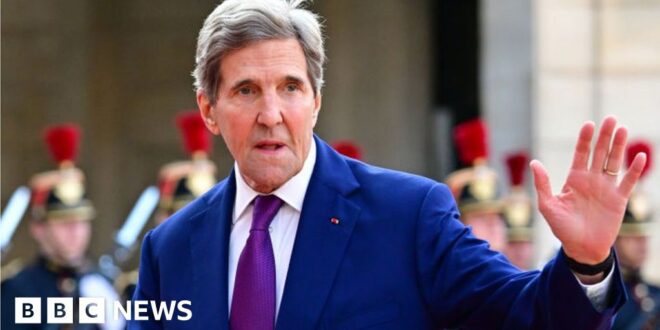## Can the US and China Find Common Ground on Climate Goals?
US special envoy on climate, John Kerry, has arrived in China to meet with his Chinese counterpart and other officials in an effort to address key climate goals. The visit comes as the US aims to restart its strained relations with Beijing, following recent visits by top officials Antony Blinken and Janet Yellen.
While the meeting is not expected to yield any concrete decisions, it is seen as a conversation starter. The two countries will likely discuss the challenges they face in transitioning to clean energy and reducing carbon emissions. China is currently the biggest investor in renewable energy, accounting for over half of global investment in this sector. However, both China and the US are also the world’s largest carbon emitters, making them significant contributors to climate change.
According to Dan Kammen, an energy professor at the University of California, Berkeley, both countries are taking steps to address climate change but are yet to see a reduction in emissions. They are caught between the demands of economic growth and the need to transition to clean energy.
China, for example, previously showed a commitment to reducing its reliance on coal. President Xi Jinping announced carbon neutrality goals in 2020 after a significant increase in clean energy infrastructure in previous years. However, recent blackouts in the country, attributed to a slowdown in coal power and droughts affecting hydropower output, have prompted a shift back to coal as a more reliable energy source.
Critics argue that this move to coal is a short-term fix and that market policies and infrastructure solutions can make clean energy supply more consistent. The US has also faced criticism, as its carbon emissions grew in 2022 due to increased natural gas consumption during extreme weather events.
During his visit, Kerry may try to persuade China to fully capitalize on its clean energy resources and achieve carbon neutrality more quickly. China aims to peak its carbon emissions by 2030 and become carbon neutral by 2060, but some argue that these goals are too far off. Additionally, the fact that China is still considered a “developing country” by the UN has drawn criticism, as it means it is held to different standards than the US and other major powers.
Both countries could also use climate issues as bargaining chips in their wider trade and political negotiations. However, experts stress the need for the US and China to set aside their rivalry and work together to address the climate crisis. In 2021, at the COP meeting, the countries announced a joint agreement to accelerate emissions reductions, signaling the potential for collaboration.
Climate engagement should not be decoupled from the overall relationship between the US and China, as the issue requires a global effort. As Li Shuo, Greenpeace East Asia’s senior global policy advisor, notes, it is essential for both countries to recognize that addressing climate change is a priority that goes beyond their disputes.
In conclusion, John Kerry’s visit to China is a crucial opportunity for the US and China to find common ground on climate goals. While there may be challenges to overcome, experts emphasize the need for collaboration in addressing the climate crisis. It is a global issue that requires the commitment of all nations involved.
 Mind Uncharted Explore. Discover. Learn.
Mind Uncharted Explore. Discover. Learn.


